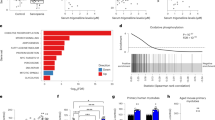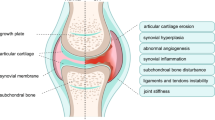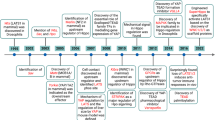Abstract
Achondroplasia is the most common genetic form of human dwarfism, for which there is presently no effective therapy. C-type natriuretic peptide (CNP) is a newly identified molecule that regulates endochondral bone growth through GC-B, a subtype of particulate guanylyl cyclase. Here we show that targeted overexpression of CNP in chondrocytes counteracts dwarfism in a mouse model of achondroplasia with activated fibroblast growth factor receptor 3 (FGFR-3) in the cartilage. CNP prevented the shortening of achondroplastic bones by correcting the decreased extracellular matrix synthesis in the growth plate through inhibition of the MAPK pathway of FGF signaling. CNP had no effect on the STAT-1 pathway of FGF signaling that mediates the decreased proliferation and the delayed differentiation of achondroplastic chondrocytes. These results demonstrate that activation of the CNP–GC-B system in endochondral bone formation constitutes a new therapeutic strategy for human achondroplasia.
This is a preview of subscription content, access via your institution
Access options
Subscribe to this journal
Receive 12 print issues and online access
$209.00 per year
only $17.42 per issue
Buy this article
- Purchase on Springer Link
- Instant access to full article PDF
Prices may be subject to local taxes which are calculated during checkout






Similar content being viewed by others
References
Oberklaid, F., Danks, D.M., Jensen, F., Stace, L. & Rosshandler, S. Achondroplasia and hypochondroplasia. Comments on frequency, mutation rate, and radiological features in skull and spine. J. Med. Genet. 16, 140–146 (1979).
Bellus, G.A. et al. Achondroplasia is defined by recurrent G380R mutations of FGFR3. Am. J. Hum. Genet. 56, 368–373 (1995).
Shiang, R. et al. Mutations in the transmembrane domain of FGFR3 cause the most common genetic form of dwarfism, achondroplasia. Cell 78, 335–342 (1994).
Cohen, M.M. Jr. Short-limb skeletal dysplasias and craniosynostosis: what do they have in common? Pediatr. Radiol. 27, 442–446 (1997).
Boilly, B., Vercoutter-Edouart, A.S., Hondermarck, H., Nurcombe, V. & Le Bourhis, X. FGF signals for cell proliferation and migration through different pathways. Cytokine Growth Factor Rev. 11, 295–302 (2000).
Sahni, M. et al. FGF signaling inhibits chondrocyte proliferation and regulates bone development through the STAT-1 pathway. Genes Dev. 13, 1361–1366 (1999).
Sahni, M., Raz, R., Coffin, J.D., Levy, D. & Basilico, C. STAT1 mediates the increased apoptosis and reduced chondrocyte proliferation in mice overexpressing FGF2. Development 128, 2119–2129 (2001).
Nakao, K., Ogawa, Y., Suga, S. & Imura, H. Molecular biology and biochemistry of the natriuretic peptide system. I: Natriuretic peptides. J. Hypertens. 10, 907–912 (1992).
Nakao, K., Ogawa, Y., Suga, S. & Imura, H. Molecular biology and biochemistry of the natriuretic peptide system. II: Natriuretic peptide receptors. J. Hypertens. 10, 1111–1114 (1992).
Garbers, D.L. Guanylate cyclase receptor family. Recent. Prog. Horm. Res. 46, 85–96 (1990).
Suda, M. et al. Skeletal overgrowth in transgenic mice that overexpress brain natriuretic peptide. Proc. Natl. Acad. Sci. USA 95, 2337–2342 (1998).
Yasoda, A. et al. Natriuretic peptide regulation of endochondral ossification. Evidence for possible roles of the C-type natriuretic peptide/guanylyl cyclase-B pathway. J. Biol. Chem. 273, 11695–11700 (1998).
Chusho, H. et al. Dwarfism and early death in mice lacking C-type natriuretic peptide. Proc. Natl. Acad. Sci. USA 98, 4016–4021 (2001).
Pfeifer, A. et al. Intestinal secretory defects and dwarfism in mice lacking cGMP-dependent protein kinase II. Science 274, 2082–2086 (1996).
Matsukawa, N. et al. The natriuretic peptide clearance receptor locally modulates the physiological effects of the natriuretic peptide system. Proc. Natl. Acad. Sci. USA 96, 7403–7408 (1999).
Jaubert, J. et al. Three new allelic mouse mutations that cause skeletal overgrowth involve the natriuretic peptide receptor C gene (Npr3). Proc. Natl. Acad. Sci. USA 96, 10278–10283 (1999).
Colvin, J.S., Bohne, B.A., Harding, G.W., McEwen, D.G. & Ornitz, D.M. Skeletal overgrowth and deafness in mice lacking fibroblast growth factor receptor 3. Nat. Genet. 12, 390–397 (1996).
Deng, C., Wynshaw-Boris, A., Zhou, F., Kuo, A. & Leder, P. Fibroblast growth factor receptor 3 is a negative regulator of bone growth. Cell 84, 911–921 (1996).
Naski, M.C., Colvin, J.S., Coffin, J.D. & Ornitz, D.M. Repression of hedgehog signaling and BMP4 expression in growth plate cartilage by fibroblast growth factor receptor 3. Development 125, 4977–4988 (1998).
Chrisman, T.D. & Garbers, D.L. Reciprocal antagonism coordinates C-type natriuretic peptide and mitogen-signaling pathways in fibroblasts. J. Biol. Chem. 274, 4293–4299 (1999).
Suganami, T. et al. Overexpression of brain natriuretic peptide in mice ameliorates immune-mediated renal injury. J. Am. Soc. Nephrol. 12, 2652–2663 (2001).
Metsaranta, M. et al. Developmental expression of a type II collagen/β-galactosidase fusion gene in transgenic mice. Dev. Dyn. 204, 202–210 (1995).
Toyokuni, S. et al. Quantitative immunohistochemical determination of 8-hydroxy-2'-deoxyguanosine by a monoclonal antibody N45.1: its application to ferric nitrilotriacetate-induced renal carcinogenesis model. Lab. Invest. 76, 365–374 (1997).
Shukunami, C. et al. Chondrogenic differentiation of clonal mouse embryonic cell line ATDC5 in vitro: differentiation-dependent gene expression of parathyroid hormone (PTH)/PTH-related peptide receptor. J. Cell. Biol. 133, 457–468 (1996).
Dudley, D.T., Pang, L., Decker, S.J., Bridges, A.J. & Saltiel, A.R. A synthetic inhibitor of the mitogen-activated protein kinase cascade. Proc. Natl. Acad. Sci. USA 92, 7686–7689 (1995).
Murakami, S., Kan, M., McKeehan, W.L. & de Crombrugghe, B. Up-regulation of the chondrogenic Sox9 gene by fibroblast growth factors is mediated by the mitogen-activated protein kinase pathway. Proc. Natl. Acad. Sci. USA 97, 1113–1118 (2000).
Yoon, Y.M. et al. Maintenance of differentiated phenotype of articular chondrocytes by protein kinase C and extracellular signal-regulated protein kinase. J. Biol. Chem. 277, 8412–8420 (2002).
Minina, E., Kreschel, C., Naski, M.C., Ornitz, D.M. & Vortkamp, A. Interaction of FGF, Ihh/Pthlh, and BMP signaling integrates chondrocyte proliferation and hypertrophic differentiation. Dev. Cell 3, 439–449 (2002).
Noonan, K.J., Leyes, M., Forriol, F. & Canadell, J. Distraction osteogenesis of the lower extremity with use of monolateral external fixation. A study of two hundred and sixty-one femora and tibiae. J. Bone. Joint. Surg. Am. 80, 793–806 (1998).
Aldegheri, R. Distraction osteogenesis for lengthening of the tibia in patients who have limb-length discrepancy or short stature. J. Bone. Joint. Surg. Am. 81, 624–634 (1999).
Tanaka, H. et al. Effect of growth hormone therapy in children with achondroplasia: growth pattern, hypothalamic-pituitary function, and genotype. Eur. J. Endocrinol. 138, 275–280 (1998).
Kanaka-Gantenbein, C. Present status of the use of growth hormone in short children with bone diseases (diseases of the skeleton). J. Pediatr. Endocrinol. Metab. 14, 17–26 (2001).
Scheven, B.A. & Hamilton, N.J. Longitudinal bone growth in vitro: effects of insulin-like growth factor I and growth hormone. Acta Endocrinol. 124, 602–607 (1991).
Dieudonne, S.C. et al. Opposite effects of osteogenic protein and transforming growth factor β on chondrogenesis in cultured long bone rudiments. J. Bone Miner. Res. 9, 771–780 (1994).
Coxam, V., Miller, M.A., Bowman, B.M., Qi, D. & Miller, S.C. Insulin-like growth factor 1 and parathyroid hormone effects on the growth of fetal rat metatarsal bones cultured in serum-free medium. Biol. Neonate. 68, 368–376 (1995).
Kojima, M., Minamino, N., Kangawa, K. & Matsuo, H. Cloning and sequence analysis of a cDNA encoding a precursor for rat C-type natriuretic peptide (CNP). FEBS Lett. 276, 209–213 (1990).
Ogawa, Y. et al. Molecular cloning and chromosomal assignment of the mouse C-type natriuretic peptide (CNP) gene (Nppc): comparison with the human CNP gene (NPPC). Genomics 24, 383–387 (1994).
Nakayama, H., Yokoi, H. & Fujita, J. Quantification of mRNA by non-radioactive RT-PCR and CCD imaging system. Nucleic Acids Res. 20, 4939 (1992).
Yokoi, H. et al. Non-radioisotopic quantitative RT-PCR to detect changes in mRNA levels during early mouse embryo development. Biochem. Biophys. Res. Commun. 195, 769–775 (1993).
Liu, W. et al. Overexpression of Cbfa1 in osteoblasts inhibits osteoblast maturation and causes osteopenia with multiple fractures. J. Cell. Biol. 155, 157–166 (2001).
Chusho, H. et al. Genetic models reveal that brain natriuretic peptide can signal through different tissue-specific receptor-mediated pathways. Endocrinology 141, 3807–3813 (2000).
Mericq, V., Uyeda, J.A., Barnes, K.M., De Luca, F. & Baron, J. Regulation of fetal rat bone growth by C-type natriuretic peptide and cGMP. Pediatr. Res. 47, 189–193 (2000).
Bonassar, L.J., Grodzinsky, A.J., Srinivasan, A., Davila, S.G. & Trippel, S.B. Mechanical and physicochemical regulation of the action of insulin-like growth factor-I on articular cartilage. Arch. Biochem. Biophys. 379, 57–63 (2000).
Maack, T. et al. Physiological role of silent receptors of atrial natriuretic factor. Science 238, 675–678 (1987).
Acknowledgements
We thank D.M. Ornitz (Department of Molecular Biology and Pharmacology, Washington University School of Medicine) for Fgfr3ach mice and B. DeCrombrugghe (Department of Molecular Genetics, University of Texas M.D. Anderson Cancer Center) for the Col2a1 promoter. This work was supported by grants from Research for the Future of the Japan Society for the Promotion of Science (JSPS-RFTF 96100204 and 98L00801); the Japanese Ministry of Education, Sciences, Sports, and Culture (# 12770627); Smoking Research Foundation; Toyobo Biochemical Foundation; and Uehara Memorial Foundation.
Author information
Authors and Affiliations
Corresponding author
Ethics declarations
Competing interests
The authors declare no competing financial interests.
Rights and permissions
About this article
Cite this article
Yasoda, A., Komatsu, Y., Chusho, H. et al. Overexpression of CNP in chondrocytes rescues achondroplasia through a MAPK-dependent pathway. Nat Med 10, 80–86 (2004). https://doi.org/10.1038/nm971
Received:
Accepted:
Published:
Issue Date:
DOI: https://doi.org/10.1038/nm971
This article is cited by
-
Is a boost to height a boost to health? Dwarfism therapies spark controversy
Nature (2023)
-
Novel therapeutic perspectives in Noonan syndrome and RASopathies
European Journal of Pediatrics (2023)
-
Collagen X Marker Levels are Decreased in Individuals with Achondroplasia
Calcified Tissue International (2022)
-
Guanylyl Cyclase-B Dependent Bone Formation in Mice is Associated with Youth, Increased Osteoblasts, and Decreased Osteoclasts
Calcified Tissue International (2022)
-
Pharmacokinetics and Exposure–Response of Vosoritide in Children with Achondroplasia
Clinical Pharmacokinetics (2022)



